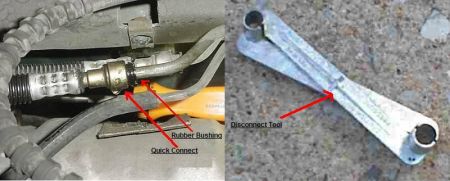Thanks for trying. I'm sure that Crank Position Sensor is the cause for fuel delivery problems in Saab 9-3's more times than not. It just didn't turn out to be the issue with my vehicle.
After days of searching I finally found a schematic drawing that showed common types of fuel line quick connectors. The type that Saab uses has rubber bushings that are pushed into the metal quick connectors to prevent debris and dirt from getting into them.
To disconnect a fuel li ne from a Saab 9-3 fuel rail:
1. Disconnect the vacuum line to the evap module so you can free up some room over the fuel lines.
2. Free up the metal connectors and rubber bushings by swiveling them back and forth around the fuel line. (This will help prevent you from damaging these parts when you actually remove them.)
3. Take a pair of pliers, (I used needle nose because there isn't much room in there.), And grab hold of one of the 3 rubber tabs that stick out perpendicularly on the bushing's side and pull the bushing up over the flair in the fuel line toward the fuel rail. You might spin the bushing as you pull it up so you don't end up tearing it. You want to pull it up enough so you can get a box end wrench between the bushing and the metal connector.
4. Insert a small wrench between the rubber bushing and the metal quick connector and finish lifting the bushing up over the flair toward the fuel rail so you'll have enough room to insert the fuel line disconnect tool. (See picture in previous post.)
5. Insert the disconnect tool into the opening of the metal quick connector and push the quick connector up onto the tool. (There appear to be 4 metal tabs distributed around the inside of the connector that snap over another flairing that is lower on the fuel line. By pushing the connector up onto the disconnect tool, you actually move those tabs back so they can slide over the flair.)
6. Push and twist the line and tool away from the fuel rail at the same time.
The fuel line will then come off.
NOW we can test the fuel pressure!
I purchased a cheap fuel pressure gauge test kit from Harbor Freight for about $16.99. I've heard you can also rent one from Autozone but I'm not sure what type adapters come with it so it might not work. You'll want an adapter that will allow you to connect the gauge inline with the fuel line. Mine came with a metal connector that resembles the fuel line on both ends so all I did was hook the quick connector from the fuel supply line to one end of it and then connected the other end to the fuel rail via a 3/8" diameter piece of rubber tubing (included in the kit.). The gauge screws perpendicularly into the metal connector tube. From there I hooked my battery up and turned my ignition switch to on. The fuel pump pressurized the line and I got my EXTREMELY low reading which confirmed that my fuel pump was bad.
Thankfully I already ordered a fuel pump which should be delivered in the next couple days, (good luck trying to find one locally.). I didn't order the whole assembly and plan to rebuild mine. Now I can drain my fuel tank and drop it in preparation for fuel pump replacement.
I posted this reply for any Saab owner that happens to run into the same issue I did. Hopefully the troubleshooting I've outlined will provide some guidance as you attempt to troubleshoot your fuel delivery issue.
Thanks,
wrang1er
Thursday, November 12th, 2009 AT 6:42 PM



